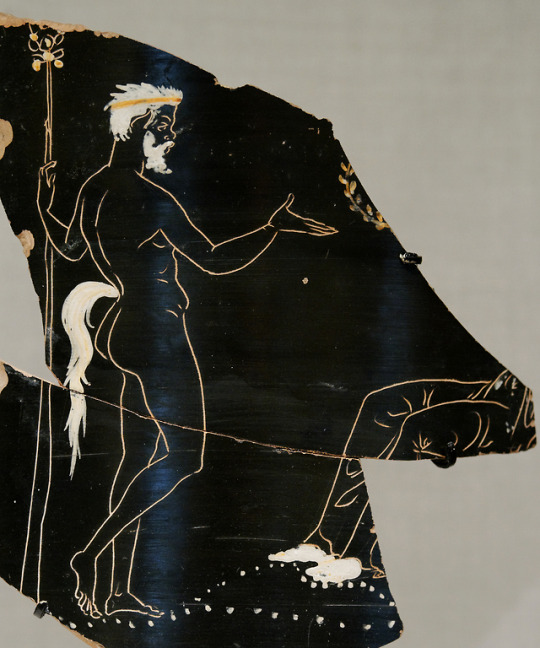#Gnathian style
Text
We spent our mini-moon in Paris, and, being the huge nerds that we are, we of course had to visit the Louvre. Prepare for a picspam of the objects we found most interesting!

Ostracon of a Bull attacking a man, Deir el-Medina, Ramesside period (~1295-1069 BC)
I’m intrigued by the man’s headpiece, is he carrying cloth or rope, or is it a halo?
https://collections.louvre.fr/en/ark:/53355/cl010008504

Model of three women making beer, MK (~2033-1670 BC)
This is a reference to @thatlittleegyptologist because of her viral pub quiz post ^^°
https://collections.louvre.fr/en/ark:/53355/cl010026102

Figurine of a cat with two kittens, Late period (~664-332 BC)
BABIES KITTIES AAAHHH
https://collections.louvre.fr/en/ark:/53355/cl010009998

Detail of the sarcophagus of Nakhtkhonsuiru, 22nd Dynasty (~943-731 BC)
GREEN PUBBY? GOOD PUBBY!
https://collections.louvre.fr/en/ark:/53355/cl010029126

Magical Papyrus, Deir el-Medina, 20th Dynasty (~1186-1069 BC)
Look at all these fancy demons! https://collections.louvre.fr/en/ark:/53355/cl010003526

Magic knife, late 12th Dynasty (~1862-1686 BC)
Also called birth tusk, made from hippopotamus ivory, probably apotropaeic. More fancy demons!
https://collections.louvre.fr/en/ark:/53355/cl010007235

Female Figurine, Middle Kingdom (~2000-1850 BC)
Also called a Bride of the Dead, I love her tattoos!
https://collections.louvre.fr/ark:/53355/cl010007299

Tiiiiny amulets of Seth, 17th Dynasty (~1630-1550 BC)
SO TINY! With a boopable snoot!
https://collections.louvre.fr/en/ark:/53355/cl010009291

Female Figurine, Gebel Zeit, 2nd Intermediate Period (~1686-1069 BC)
There’s a whole bunch of these figurines in the Louvre and I’d honestly never seen those before, they’re really intriguing! They’re described as Figurines of women honouring Hathor over on Wikipedia.
https://collections.louvre.fr/en/ark:/53355/cl010030514

Fayence Bracelet, Amenhotep III (~1390-1352 BC)
I would wear this! You can very nicely see “imn-Htp HqA wAs.t” written in the cartouche!
https://collections.louvre.fr/ark:/53355/cl010007064

Bowl with painting of Taweris, 18th Dynasty (~1550-1425 BC)
Ok this *might* be some other badass hippopotamus- or even cow-shaped deity, (Mehet-Weret anyone?), but isn’t she amazing?
https://collections.louvre.fr/en/ark:/53355/cl010037508

Ostracon with a cat and mouse, Deir el-Medina, Ramesside period (~1295-1069 BC)
Remember that post by @neil-gaiman? About Pharao Pnw? Here’s another one, Pnw VI!
https://collections.louvre.fr/en/ark:/53355/cl010051679

Ostracon showing Meretseger, Deir el-Medina, Ramesside period (~1295-1069 BC)
Meretseger (my beloved) was the local deity of Deir el-Medina, she’s usually depicted as a very wiggly snek, sometimes with a fancy headdress :3
https://collections.louvre.fr/en/ark:/53355/cl010003996

Stela of Taperet, Thebes, 22th Dynasty (~745-730 BC)
LAZER-RA STRIKES AGAIN! PEW PEW PEW
https://collections.louvre.fr/en/ark:/53355/cl010017961

Etrurian plate, Gnathian Style (~300-275 BC)
FLOOF! Possibly a puppy, possibly a mythological creature, definitely pettable!
https://collections.louvre.fr/en/ark:/53355/cl010302663

Cypriot vase, Geometric style (~850-600 BC)
Uh, so according to the Louvre this is a dog??? Did it get stung by a bee??? And other literature says it’s a lion??? Anyway, cute creature!
https://collections.louvre.fr/en/ark:/53355/cl010131699
15 notes
·
View notes
Photo

Hydra der Gnathia Ware
Blackglaze hydria with flaring rim adorned with a plastically moulded egg-and-dart frieze. The body is ribbed exept for a narrow band below the handles. Two horizontal, profiled handles rise from just below the shoulder. A strap handle runs vertically from neck to shoulder. White-yellow decoration: paint on egg-and-dart frieze on the rim, tendrils in the band below the handles and garland of lanceolate leaves on the neck. A band of red glaze on the rim, where the stem joins the body and on the outside of the foot. The Gnathian style was invented in Taranto, probably in the workshop pf the Iliopersis Painter, a proponent of the Apulian 'ornate style' (370-360 BC). In 330-320 this pottery reached its height in popularity. The production of this style ceased around the date 270 BC.
H. 46.3 cm.
#Hydra der Gnathia Ware#clay#pottery#ancient artifacts#archeology#archeolgst#history#history news#ancient history#ancient culture#ancient civilizations#ancient art
35 notes
·
View notes
Photo

Silenus speaks to a woman. Fragment of an Apulian krater in the Gnathian style, artist unknown; ca. 360-340 BCE. Now in the Metropolitan Museum of Art. Photo credit: Marie-Lan Nguyen/Wikimedia Commons.
#classics#tagamemnon#Ancient Greece#Classical Greece#Magna Graecia#Apulia#classical mythology#Silenus#Silenos#art#art history#ancient art#Greek art#Ancient Greek art#Classical Greek art#South Italian art#Apulian art#vase painting#krater#Gnathia style#Gnathian style#Metropolitan Museum of Art
1K notes
·
View notes